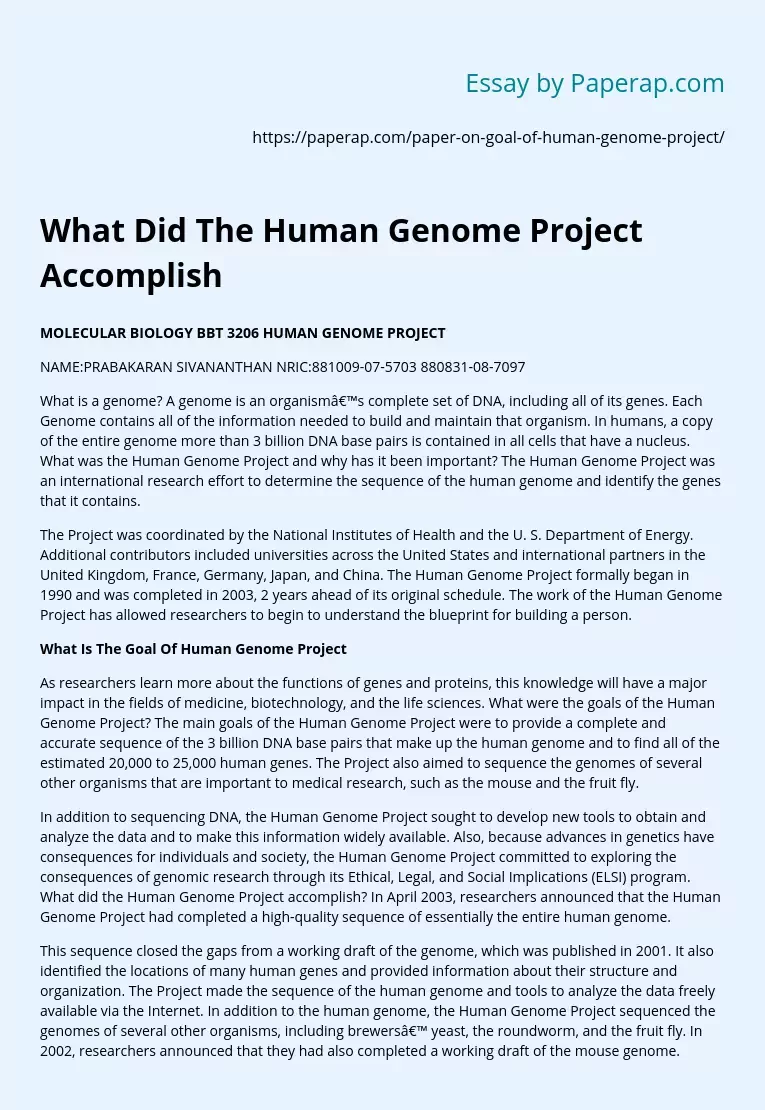MOLECULAR BIOLOGY BBT 3206 HUMAN GENOME PROJECT
NAME:PRABAKARAN SIVANANTHAN NRIC:881009-07-5703 880831-08-7097
What is a genome? A genome is an organism’s complete set of DNA, including all of its genes. Each Genome contains all of the information needed to build and maintain that organism. In humans, a copy of the entire genome more than 3 billion DNA base pairs is contained in all cells that have a nucleus. What was the Human Genome Project and why has it been important? The Human Genome Project was an international research effort to determine the sequence of the human genome and identify the genes that it contains.
The Project was coordinated by the National Institutes of Health and the U. S. Department of Energy. Additional contributors included universities across the United States and international partners in the United Kingdom, France, Germany, Japan, and China. The Human Genome Project formally began in 1990 and was completed in 2003, 2 years ahead of its original schedule. The work of the Human Genome Project has allowed researchers to begin to understand the blueprint for building a person.
What Is The Goal Of Human Genome Project
As researchers learn more about the functions of genes and proteins, this knowledge will have a major impact in the fields of medicine, biotechnology, and the life sciences. What were the goals of the Human Genome Project? The main goals of the Human Genome Project were to provide a complete and accurate sequence of the 3 billion DNA base pairs that make up the human genome and to find all of the estimated 20,000 to 25,000 human genes.
The Project also aimed to sequence the genomes of several other organisms that are important to medical research, such as the mouse and the fruit fly.
In addition to sequencing DNA, the Human Genome Project sought to develop new tools to obtain and analyze the data and to make this information widely available. Also, because advances in genetics have consequences for individuals and society, the Human Genome Project committed to exploring the consequences of genomic research through its Ethical, Legal, and Social Implications (ELSI) program. What did the Human Genome Project accomplish? In April 2003, researchers announced that the Human Genome Project had completed a high-quality sequence of essentially the entire human genome.
This sequence closed the gaps from a working draft of the genome, which was published in 2001. It also identified the locations of many human genes and provided information about their structure and organization. The Project made the sequence of the human genome and tools to analyze the data freely available via the Internet. In addition to the human genome, the Human Genome Project sequenced the genomes of several other organisms, including brewers’ yeast, the roundworm, and the fruit fly. In 2002, researchers announced that they had also completed a working draft of the mouse genome.
By studying the similarities and differences between human genes and those of other organisms, researchers can discover the functions of particular genes and identify which genes are critical for life. The Project’s Ethical, Legal, and Social Implications (ELSI) program became the world’s largest bioethics program and a model for other ELSI programs worldwide. For additional information about ELSI and the program’s accomplishments, please refer to what were some of the ethical, legal, and social implications addressed by the Human Genome Project?
What were some of the ethical, legal, and social implications addressed by the Human Genome Project? The Ethical, Legal, and Social Implications (ELSI) program was founded in 1990 as an integral part of the Human Genome Project. The mission of the ELSI program was to identify and address issues raised by genomic research that would affect individuals, families, and society. A percentage of the Human Genome Project budget at the National Institutes of Health and the U. S. Department of Energy was devoted to ELSI research.
The ELSI program focused on the possible consequences of genomic research in four main areas:
- Privacy and fairness in the use of genetic information, including the potential for genetic discrimination in employment and insurance.
- The integration of new genetic technologies, such as genetic testing, into the practice of clinical medicine.
- Ethical issues surrounding the design and conduct of genetic research with people, including the process of informed consent.
- The education of healthcare professionals, policy makers, students, and the public about genetics and the complex issues that result from genomic research.
What Did The Human Genome Project Accomplish. (2019, Dec 05). Retrieved from https://paperap.com/paper-on-goal-of-human-genome-project/

